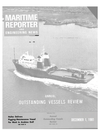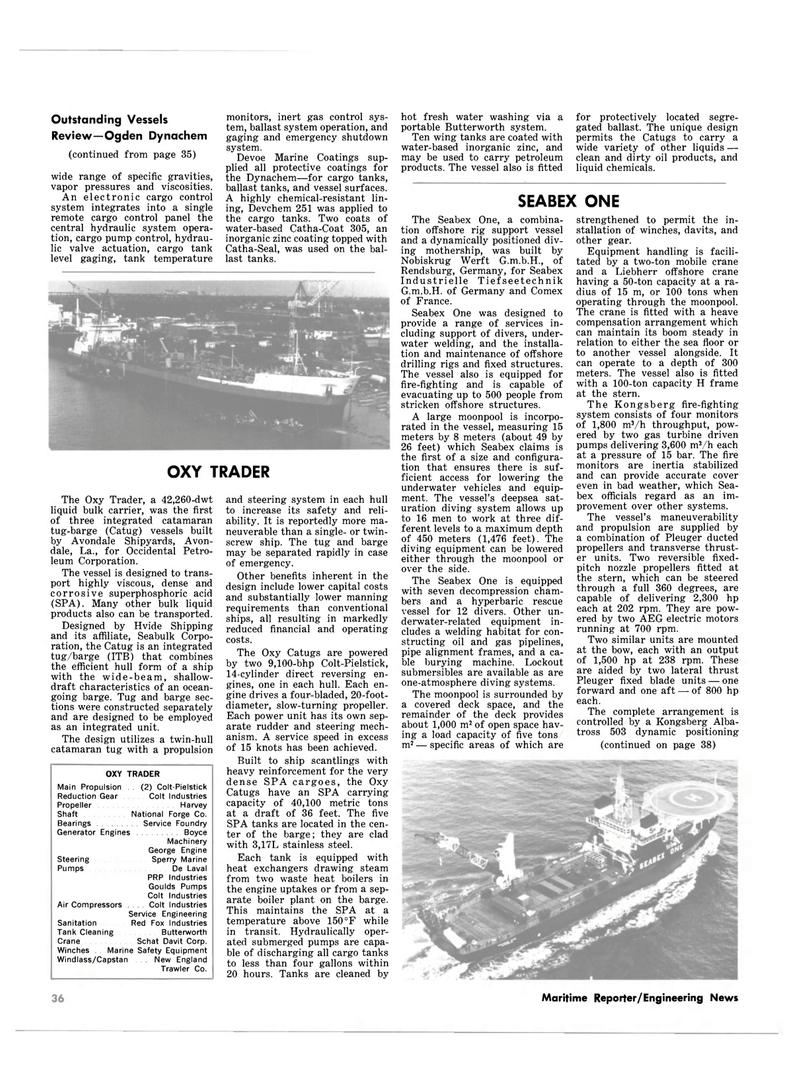
Page 26: of Maritime Reporter Magazine (December 1981)
Read this page in Pdf, Flash or Html5 edition of December 1981 Maritime Reporter Magazine
Outstanding Vessels
Review—Ogden Dynachem (continued from page 35) wide range of specific gravities, vapor pressures and viscosities.
An electronic cargo control system integrates into a single remote cargo control panel the central hydraulic system opera- tion, cargo pump control, hydrau- lic valve actuation, cargo tank level gaging, tank temperature monitors, inert gas control sys- tem, ballast system operation, and gaging and emergency shutdown system.
Devoe Marine Coatings sup- plied all protective coatings for the Dynachem—for cargo tanks, ballast tanks, and vessel surfaces.
A highly chemical-resistant lin- ing, Devchem 251 was applied to the cargo tanks. Two coats of water-based Catha-Coat 305, an inorganic zinc coating topped with
Catha-Seal, was used on the bal- last tanks.
OXY TRADER
The Oxy Trader, a 42,260-dwt liquid bulk carrier, was the first of three integrated catamaran tug-barge (Catug) vessels built by Avondale Shipyards, Avon- dale, La., for Occidental Petro- leum Corporation.
The vessel is designed to trans- port highly viscous, dense and corrosive superphosphoric acid (SPA). Many other bulk liquid products also can be transported.
Designed by Hvide Shipping and its affiliate, Seabulk Corpo- ration, the Catug is an integrated tug/barge (ITB) that combines the efficient hull form of a ship with the wide-beam, shallow- draft characteristics of an ocean- going barge. Tug and barge sec- tions were constructed separately and are designed to be employed as an integrated unit.
The design utilizes a twin-hull catamaran tug with a propulsion
OXY TRADER
Main Propulsion (2) Colt-Pielstick
Reduction Gear Colt Industries
Propeller Harvey
Shaft National Forge Co.
Bearings Service Foundry
Generator Engines Boyce
Machinery
George Engine
Steering Sperry Marine
Pumps De Laval
PRP Industries
Goulds Pumps
Colt Industries
Air Compressors Colt Industries
Service Engineering
Sanitation Red Fox Industries
Tank Cleaning Butterworth
Crane Schat Davit Corp.
Winches Marine Safety Equipment
Windlass/Capstan New England
Trawler Co. and steering system in each hull to increase its safety and reli- ability. It is reportedly more ma- neuverable than a single- or twin- screw ship. The tug and barge may be separated rapidly in case of emergency.
Other benefits inherent in the design include lower capital costs and substantially lower manning requirements than conventional ships, all resulting in markedly reduced financial and operating costs.
The Oxy Catugs are powered by two 9,100-bhp Colt-Pielstick, 14-cylinder direct reversing en- gines, one in each hull. Each en- gine drives a four-bladed, 20-foot- diameter, slow-turning propeller.
Each power unit has its own sep- arate rudder and steering mech- anism. A service speed in excess of 15 knots has been achieved.
Built to ship scantlings with heavy reinforcement for the very dense SPA cargoes, the Oxy
Catugs have an SPA carrying capacity of 40,100 metric tons at a draft of 36 feet. The five
SPA tanks are located in the cen- ter of the barge; they are clad with 3,17L stainless steel.
Each tank is equipped with heat exchangers drawing steam from two waste heat boilers in the engine uptakes or from a sep- arate boiler plant on the barge.
This maintains the SPA at a temperature above 150°F while in transit. Hydraulically oper- ated submerged pumps are capa- ble of discharging all cargo tanks to less than four gallons within 20 hours. Tanks are cleaned by hot fresh water washing via a portable Butterworth system.
Ten wing tanks are coated with water-based inorganic zinc, and may be used to carry petroleum products. The vessel also is fitted for protectively located segre- gated ballast. The unique design permits the Catugs to carry a wide variety of other liquids — clean and dirty oil products, and liquid chemicals.
SEABEX ONE
The Seabex One, a combina- tion offshore rig support vessel and a dynamically positioned div- ing mothership, was built by
Nobiskrug Werft G.m.b.H., of
Rendsburg, Germany, for Seabex
Industrielle Tief seetechnik
G.m.b.H. of Germany and Comex of France.
Seabex One was designed to provide a range of services in- cluding support of divers, under- water welding, and the installa- tion and maintenance of offshore drilling rigs and fixed structures.
The vessel also is equipped for fire-fighting and is capable of evacuating up to 500 people from stricken offshore structures.
A large moonpool is incorpo- rated in the vessel, measuring 15 meters by 8 meters (about 49 by 26 feet) which Seabex claims is the first of a size and configura- tion that ensures there is suf- ficient access for lowering the underwater vehicles and equip- ment. The vessel's deepsea sat- uration diving system allows up to 16 men to work at three dif- ferent levels to a maximum depth of 450 meters (1,476 feet). The diving equipment can be lowered either through the moonpool or over the side.
The Seabex One is equipped with seven decompression cham- bers and a hyperbaric rescue vessel for 12 divers. Other un- derwater-related equipment in- cludes a welding habitat for con- structing oil and gas pipelines, pipe alignment frames, and a ca- ble burying machine. Lockout submersibles are available as are one-atmosphere diving systems.
The moonpool is surrounded by a covered deck space, and the remainder of the deck provides about 1,000 mJ of open space hav- ing a load capacity of five tons m2 — specific areas of which are strengthened to permit the in- stallation of winches, davits, and other gear.
Equipment handling is facili- tated by a two-ton mobile crane and a Liebherr offshore crane having a 50-ton capacity at a ra- dius of 15 m, or 100 tons when operating through the moonpool.
The crane is fitted with a heave compensation arrangement which can maintain its boom steady in relation to either the sea floor or to another vessel alongside. It can operate to a depth of 300 meters. The vessel also is fitted with a 100-ton capacity H frame at the stern.
The Kongsberg fire-fighting system consists of four monitors of 1,800 m3/h throughput, pow- ered by two gas turbine driven pumps delivering 3,600 m3/h each at a pressure of 15 bar. The fire monitors are inertia stabilized and can provide accurate cover even in bad weather, which Sea- bex officials regard as an im- provement over other systems.
The vessel's maneuverability and propulsion are supplied by a combination of Pleuger ducted propellers and transverse thrust- er units. Two reversible fixed- pitch nozzle propellers fitted at the stern, which can be steered through a full 360 degrees, are capable of delivering 2,300 hp each at 202 rpm. They are pow- ered by two AEG electric motors running at 700 rpm.
Two similar units are mounted at the bow, each with an output of 1,500 hp at 238 rpm. These are aided by two lateral thrust
Pleuger fixed blade units — one forward and one aft —- of 800 hp each.
The complete arrangement is controlled by a Kongsberg Alba- tross 503 dynamic positioning (continued on page 38) 20 Maritime Reporter/Engineering News

 25
25

 27
27
